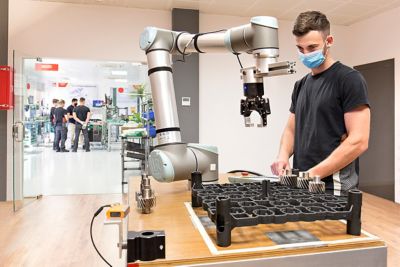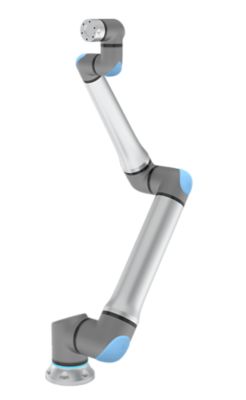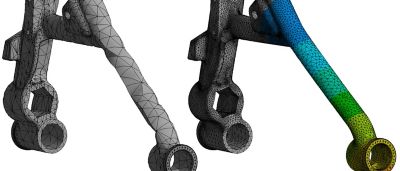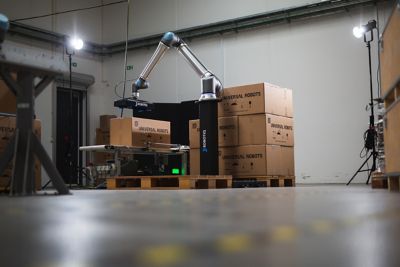-
United States -
United Kingdom -
India -
France -
Deutschland -
Italia -
日本 -
대한민국 -
中国 -
台灣
-
Ansys si impegna a fare in modo che gli studenti di oggi abbiano successo, fornendogli il software gratuito di simulazione ingegneristica.
-
Ansys si impegna a fare in modo che gli studenti di oggi abbiano successo, fornendogli il software gratuito di simulazione ingegneristica.
-
Ansys si impegna a fare in modo che gli studenti di oggi abbiano successo, fornendogli il software gratuito di simulazione ingegneristica.
-
Contattaci -
Opportunità di lavoro -
Studenti e Accademici -
Per Stati Uniti e Canada
+1 844.462.6797
ANSYS BLOG
February 1, 2023
Universal Robots Develops Collaborative Robot Arms Using Simulation
Robots in any form are pretty cool. In fact, some are so cutting-edge that it’s hard to imagine that they could be any more innovative. However, many human-like machines are heavy, clunky, and cumbersome. As technology advances and demands increase, robot manufacturers are tasked with creating next-generation robots that are lighter, compact, and more capable than their weighty ancestors.
Universal Robots (UR), based in Denmark, is using Ansys’ multiphysics simulation to make this possible by creating smaller, flexible, industrial collaborative robot arms called cobots. The latest model in the bunch — the UR20 — is the company’s first, next-generation cobot. It is set to arrive to customers later this year.

To create the advanced model, UR engineers integrated Ansys Mechanical finite element analysis (FEA) software, Ansys Motion multibody dynamics simulation, and Ansys nCode DesignLife durability and fatigue prediction analysis. As a result, UR reduced costs, minimized physical testing, and increased productivity as they used these tools to help create the new UR20, which has the potential to revolutionize industrial equipment.
Less is More: Compact Robotic Designs
Featuring an impressive 1750-millimeter-reach and 20-kilogram-payload capacity, the UR20 can handle more tasks, fit more applications, and assist in more environments than ever before. Some of these tasks include palletizing, welding, materials handling, machine loading, and machine tending.
But what makes this cobot so next-gen? For starters, the UR20 boasts a 50% part reduction in each joint. Additionally, this neater and cleaner design increases reliability, which results in decreased service requests and downtime.
Simon Søndergård Taber, Research and Development (R&D) hardware manager at UR, and his team relied on Mechanical for structural analysis as well as parametric, shape (mesh morphing), and topology optimization. Engineers used Motion — which is in the Mechanical interface — for multibody dynamics such as system motion performance, stress-safety analysis, vibration, and fatigue. nCode — which is also used in tandem with Mechanical — helped designers evaluate the fatigue life of the UR20. Using the FEA simulation results from Mechanical, nCode analyzes damage from repetitive loading to determine a product’s predicted life.
“We have used products such as Ansys Mechanical, Ansys Motion, and Ansys nCode to a great extent to optimize the structural components of the UR20. By combining them, we have been able to perform virtual tests, maximize stiffness and durability, while removing any excess weight which helps us maximize the overall performance of the cobot,” says Taber. “This improved performance helps our customers meet their goals of increased throughput.”
The most unique aspect of the UR20 is its joint architecture, which was created completely from scratch and differs from earlier UR models.
For example, the new joint design increases all joint torques by approximately 25% and joint speeds by 30% and in some cases, depending on joint size, up to 65%.
Consequently, designers can keep the cobot’s weight down.
Taber says his motto is, “a gram removed is a gram gained.”
“Since the cobot arm must lift its own weight, every gram matters. Any weight reduction helps us either increase performance or increase the cobot's payload capacity,” says Taber. “This is why weight optimization is really crucial for us.”
UR20 specifications
- Reach: 1,750 mm / 68.9 in
- Payload: 20 kg / 44.1 lbs
- Footprint/Size: 245 mm diameter
- Weight: 64 kg / 141.1 lbs
The goal is to produce a cobot that is as rigid and lightweight as possible. Reducing weight makes the cobot easier to deploy and redeploy, and improves its overall payload capacity. However, reducing weight can often sacrifice the rigidity of the product. Simulation enables UR to keep an optimal balance between weight and rigidity.

The UR20 is Universal Robot’s first next-generation model, boasting a 50% part reduction from earlier models and more durable joint architecture.
“That's why we use Ansys for structural optimization to maximize rigidity, reduce weight, and maximize performance while ensuring that we fulfill all structural requirements, all of which is done before we build any physical prototypes,” says Taber.
The latest joint design features enhanced, fully closed capsules that increase stiffness unlike UR’s other models that bear an open design with removable lids. Additionally, the team implemented motion control capabilities into the UR20 to better monitor and manage payload capacity for safety.
“The UR20 is the first in Universal Robots’ next generation of industrial collaborative robots. It was redesigned from the ground up, from the software supporting the new active vibration dampening capabilities to the joint powertrain that brings up speed and torque within a closed capsule,” says Taber. “We have taken all the experience and knowledge gained from having built and sold more than 50,000 cobots and applied that to create the best and most powerful cobot ever made by UR.”
Cobots' Multiphysics Systems Require Multiphysics Simulation
Cobots and robots are relatively complex and heavily coupled multiphysics systems. For this reason, Ansys’ multiphysics simulation is a crucial part of UR simulation capabilities, he says.
In addition to optimizing structural components for fatigue, stiffness, and weight, Ansys’ tools enabled UR to see beyond the model.
“It can be difficult to make accurate system-level predictions based on only single physics simulations,” he says. “That's why we believe that Ansys’ multiphysics simulation could enable us to evaluate new designs on a system level much earlier in the development process than previously.
In consequence, we would not have to rely on physical testing to the same extent as we do today. This could not only help us by reducing the number of physical prototypes, but perhaps even more interestingly, it could enable us to rapidly test new designs, perform virtual tests, and create faster design iterations.”
UR first integrated Ansys simulation in 2018 and it became particularly beneficial during the pandemic when most manufacturers faced supply chain issues. As manufacturers met challenges gathering components and materials for physical prototypes, virtual design offered an easier alternative.
Today, UR continues to rely heavily on simulation throughout all stages of design.

"Simulation has become an ever-increasing part of our development process and today we use Ansys’ products on a daily basis for design evaluation, design optimization, virtual validations, and input for physical testing,” says Taber. "We use a design-build-test-learn loop in our development process, and naturally, this can be very expensive and tedious when it comes to hardware development and physical testing. However, by having virtual testing and simulation capabilities, we can accelerate this loop significantly.”
This continuous insight from simulation helps UR engineers design better cobots and limit late-stage design failure, which is often most costly.
By using simulation, UR has reduced physical prototypes, which saves time, material costs, and operational costs. Still, Taber says the real value of simulation is that it enables them to create even better products. For example, without simulation product development could involve multiple physical prototypes, however, with simulation, this can be reduced dramatically and sometimes down to one single physical prototype. By eliminating physical trial-and-error attempts and unnecessary physical prototypes, the team is freed up to focus on enhancing the design and product even more. With more time to perfect one prototype, design success improves and, ultimately, so does product performance, quality, and reliability.
“Simulation not only helps us create better designs, it also provides valuable input to improve and target our verification tests,” says Taber. “This has many obvious benefits, but for us the most critical one is that it allows us to gain better insights and ultimately, better designs.”

The UR20 can handle tasks including palletizing, welding, materials handling, and more.
Cobots are the Future of Industrial Equipment
Automation and multiphysics simulation are impacting the fourth industrial revolution. Both technologies improve the efficiency, reliability, durability, and performance of industrial equipment. Cobots help drive down costs, save energy, and minimize waste. In this way, choosing a cobot, much like choosing simulation, can also help customers reduce their carbon footprint.
In addition to UR’s use of Mechanical, Motion, and nCode, the team finds additional support through the online Ansys Learning Hub and has started to explore Ansys optiSLang, Ansys HPC Solutions, and Ansys Twin Builder for upcoming projects.
“It is important for us that our simulation partner covers our needs in relation to the simulation of relevant physics, but also their multi-physics interactions and couplings on a system level,” says Taber. “Because of this, Ansys has been a great partner for us given the large selection of multiphysics simulation tools, and perhaps even more owing to the great support and collaboration that we have experienced over the years from Ansys’ talented engineers and developers who truly helped us achieve our simulation goals.”

The first load of UR20 robots is expected to ship during the second quarter of 2023.
The UR20 has already earned industry praise receiving the 2022 IDEA Award in the category of robotics and the 2022 LEAP Award in the category of industrial automation. The first load of UR20 cobots is expected to ship during the second quarter of 2023. As high demand is anticipated, individual customer delivery dates may vary.
Learn more about Universal Robots or discover Ansys’ multiphysics simulation solutions.










